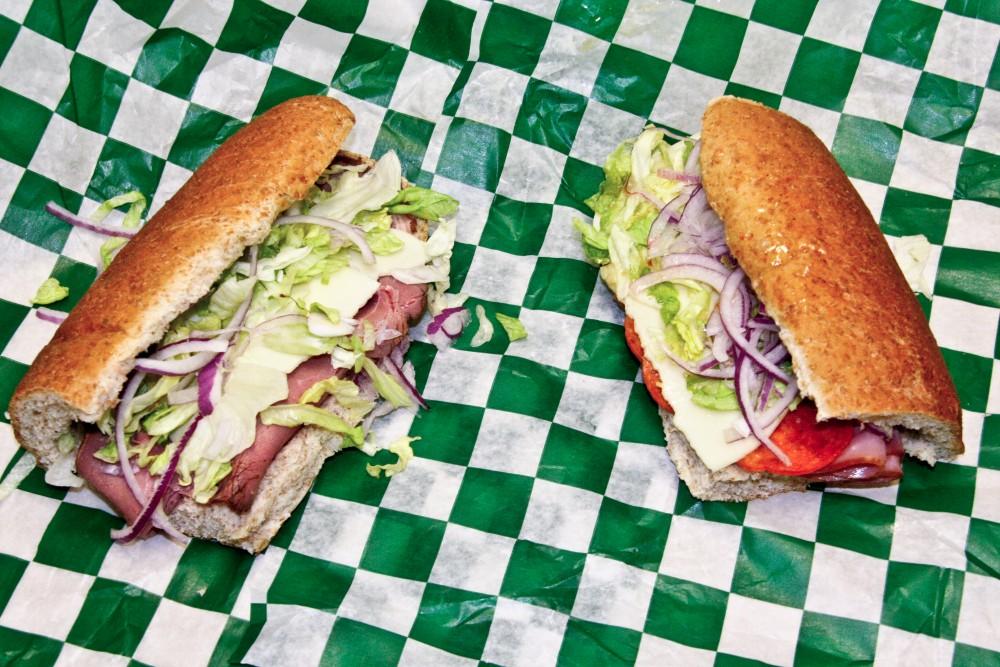Eating healthy on campus not as easy as 1-2-3

Subs that are offered at Engrained
Feb 17, 2011
Steven Nizielski, adviser for the nutrition emphasis in biomedical science, said the food offered through GVSU Campus Dining is “a mixed bag.”
“Healthy choices are available, but many choices are far too high in fat, saturated fat and sodium,” he said. “That is why it is a good idea to refer to the nutritional information when it is available. As an example, a current promotion that Campus Dining is offering is ‘free fry with purchase of sandwich.’ Clearly this is not promoting healthy choices, particularly in view of the fact that currently over 35 percent of adults in the U.S. are obese.”
This semester, 3,498 students have meal plans. However, according to one student-produced survey, 84 percent of students feel that dining facilities on campus act as a barrier to healthy eating despite frequently eating at on-campus restaurants. Then-senior Jennifer Nisenbaum’s 2010 study, “Factors Influencing Weight Gain in Grand Valley State University Students,” surveyed 133 students about their eating habits, activity levels and weight gain.
Nisenbaum found that while 59 percent of students said they usually tried to eat healthily, a majority also had unhealthy eating habits, such as regularly eating after 10 p.m.
“Some of it has to be that it’s a student’s life, and you’re hungry and it’s late at night, so part of (the solution) might be to offer healthier alternatives late at night so you’re not eating Jimmy John’s or pizza,” said Debbie Lown, a nutrition adviser who mentored Nisenbaum on the study.
The Late Night Menu at Kleiner Marketplace varies from night to night but often features menu items such as brownie sundaes, mozzarella sticks, chili cheese fries, buffalo wings and nachos. According to Deb Rambadt, marketing manager at Campus Dining, healthier options have been offered in the past but have proved unpopular with customers.
“What we find is that we try to serve what the students are asking for, and quite honestly they vote with their dollars,” Rambadt said. “We have provided more healthy options along with the ones that are clearly not healthy, and they pick the less healthy options, especially late at night. That doesn’t mean that is all we will ever offer, but if students begin to indicate with their dollars that that’s what they’re looking for, then we could reconsider that.”
Nutritional information for most on-campus restaurants is available on Campus Dining’s website, www.gvsu.edu/campusdine. However, not all menus have their nutritional content posted – information for Zoca’s, Caliente, Croutons and Kleiner Late Night menus is unavailable. Ingredient lists are also not available for menu items in any of the restaurants.
“One of the greatest challenges is that in most of our locations, meals are made to order,” Rambadt said. “That can greatly alter the nutritional information, and that is our greatest challenge. Because we provide the ability to customize, it reduces our ability to provide nutritional information.”
According to Rambadt, nutritional information for made-to-order items, such as deli sandwiches, is calculated using baseline ingredients.
“It might be a standard bun, a protein and so forth, but then again, depending on what toppings or condiments are added, it can completely change it.”
That means that the calorie and fat count for a classic turkey sub at Engrained, which clocks in at 608 calories as calculated by Campus Dining, could skyrocket with the addition of cheese, mayonnaise and other extras.
Nisenbaum’s survey showed that almost 2/3 of students were unaware that nutritional content was posted online. Rambadt said that Campus Dining has discussed the possibility of posting nutritional information in their restaurants, but there are no current plans to do so.
Nizielski said that making nutritional information available has been shown to influence consumers to make better decisions.
“Evidence indicates that a majority of the public, including college students, desire access to nutrition information when selecting menu items at restaurants,” he said. “Furthermore, for those who use this information, access to nutrition information results in individuals making more healthful choices.”
Rambadt said that Campus Dining is open to hearing student comments and concerns about nutrition on campus. In the meantime, Lown said she believes making information more accessible is an important step on the road to a more health-conscious campus.
“Whether they’ll utilize that is another thing but the first step would be advertising to students to make sure they know that’s available to them.”





















